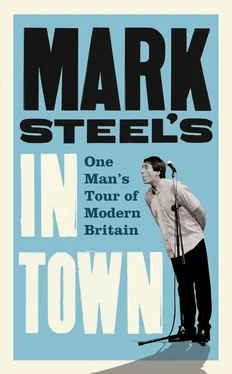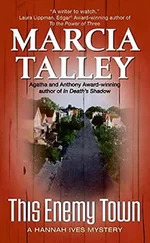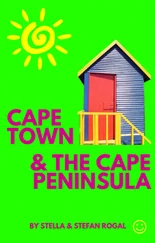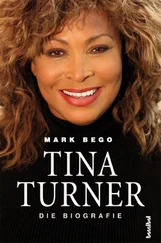It’s symbolic that in order to get a Football League team, Milton Keynes bypassed the route of developing a club within the community, and brought one in, the MK Dons, a team that had been Wimbledon in South London until its owners took it as a franchise and planted it in its new home.
What you feel the town needs is grubbiness. It needs a market with kids’ clothes tattily piled on a table next to a man with sideburns selling second-hand CDs by the Average White Band and Supertramp. It needs an area the rest of the town warns you not to go, a kebab shop that’s the subject of rumours about missing puppies and a pub that everyone claims to have been in on the night Mad Jimmy went berserk with a cattle prod.
Where the old socialist planners and modern corporate planners agree is that society, and the towns that make a society, should be organised from above. But in time Milton Keynes will develop a soul from within. There will inevitably be bands and rappers, poets and writers who complain eloquently about the town and so help to give it a human touch. Eventually the football supporters will identify with the team enough to moan incessantly about it, and it will become part of the community.
One day the protest groups, the graffiti artists, the eccentrics and flawed shards of humanity that make a town whole will emerge. They’ll shave corners off the angles and put irregular-shaped objects in the centre, and while the original architects might shudder at the unravelling of their plans, Milton Keynes will become a town at last.
Birmingham Birmingham Didcot, Oxford Wilmslow Wigan Horwich London Outer London Hereford Norwich Boston Surrey Merthyr Tydfil Edinburgh Orkney Dumfries Andersonstown Colchester Exeter Portland Motorways Yorkshire Nottingham Coventry Walsall Lewes Gateshead Kent Bristol Conclusion Bibliography Acknowledgements About the Author Also by the Author About the Publisher
I’m not sure why Birmingham is so disliked, but it is. People try to change its image by renovating the Bullring Centre every couple of years, and its citizens often tell you the city has more miles of canals than Venice, but it makes no difference. It’s like the last year of a discredited government, when ministers are changed, and policies relaunched, but no one notices, because by now the Chancellor could give everyone a bar of gold and people would say, ‘Typical of the thieving bastards.’
Maybe it’s the train station that does it. It’s surely the gloomiest, dingiest station for any major city in Britain. On the way there, you clatter past the airport and fields and light and the football ground, but this openness doesn’t make you feel at all free and airy, because you know it means you’re hurtling towards the damp darkness of New Street station, just as you wouldn’t think, ‘Ah, what a delightful breeze to set me up for the day,’ if you were a prisoner sailing across San Francisco Bay to start your time in Alcatraz.
The layout has been carefully designed so that on the platforms no sunlight can enter, even on midsummer day, like Stonehenge in reverse. The first time you go there you think, this can’t possibly be the station for Britain’s second city, and assume the train took a wrong turning and went down a disused mine-shaft. Then hundreds of people struggle with their cases along the unlit narrow platforms, like refugees from the Russian pogroms, though at least those lucky bastards had a crying family to greet them and put their luggage on a donkey. At New Street there’s a search for the stairs to the Bullring, where, even if you’ve been there fifty times before, you stand and look around for several minutes thinking, ‘Now where am I supposed to go?’
Because you’re in a traffic roundabout you can only escape from by navigating subways and uncrossable intersections that no map can help with. So you submerge yourself into the concrete, deciding to follow a path and seeing where it takes you, becoming so confused you wouldn’t be surprised if you came out opposite the Hanging Gardens of Babylon. Even in the middle of the city you’re surrounded by flyovers and vast traffic islands that make you feel you’re really not meant to be there, as if you’ve accidentally wandered into a military zone, and you expect an official to come running towards you screaming at you to get down, and launching an investigation into how you got in without anyone noticing.
Even in a car you get hopelessly, flailingly lost amidst the motorways and flyovers that govern the centre of the town. Surely motorways are supposed to link cities, not circulate around the middle of them. If you’re going from Leeds to London a motorway is handy, but if you’re popping out for a packet of biscuits you shouldn’t need to take the M6 to junction 5 and find the seventh exit off the Aston interchange that leads to the Spar.
What you mustn’t do is miss your turning. You see the bit of Birmingham you want to go to, maybe even passing right by the exact building. And you look up at the road sign that tells you to get in this lane for Birmingham east and keep straight on for Birmingham south-east and straight on then back in a loop and sort of diagonally across and round again for Birmingham east by south-east, and you scream, ‘What? Which?’ to yourself, and try to hedge your bets by straddling three lanes at once until you feel the whole motorway is hooting in a Birmingham accent, and you follow the lane that you decide is logical but now you’re going back past the building you’re supposed to be at, unable to exit the motorway. This shouldn’t be too much of a problem, you assure yourself, as you can easily take the next exit and find your way back, but you go a mile and then another mile and past the city centre and there’s no way off, then fields start appearing and it begins to get dark and you can only look forward to running out of petrol so you can get taken home by the RAC.
When I first had to negotiate the matrix that is Birmingham city centre it explained a scene I’d often experienced in my youth. My mum’s side of the family lived in Erdington, and whenever we visited them my dad would spend the first forty minutes of our stay stood on the doorstep with my granddad discussing the route.
Bottlenecks at Bearwood and cut-throughs at Stetchford were traded with new roundabouts in Digbeth and roadworks up the Bristol Road until it seemed they must have exhausted every possible route from anywhere to anywhere without working out how to get through Birmingham, and would soon decide, ‘So next time I’ll go back through Longbridge, across to Edgbaston, drive across the cricket ground to deep square leg, up to New Street station onto the gloomy chilly track and get the train, ’cos I’m buggered if I know how to get here by car.’
It can’t just be the inaccessible, terrifying centre that makes it so hard to sell Birmingham as an attractive city. Even people who don’t have to suffer the rigmarole of getting there because they already live there find it hard to be cheerful about their town. I wanted to be positive myself, so I had to ignore websites called – and I’m afraid these are all real – ‘Erdington is a Shithole’, ‘Bearwood is a Shithole’ and ‘Smethwick is a Shithole’. I think they’re all independent and not part of the shithole franchise, but eventually I found one that actually promotes the city, called ‘Birmingham is not Shit’. (I showed it to my son and he said, ‘The sad thing is that’s the official council website.’)
The blurb explaining itself goes: ‘“Birmingham is not Shit” loves Birmingham’s people, arts, animals, buildings and grass verges.’ I’m not sure this is encouraging, when you’re trying to promote the positive side of the second biggest city in Britain, and after four things you’re down to the grass verges. ‘Birmingham is not Shit’ launched a competition for Brummie of the Year, and I thought, ‘Ah, that’s quite sweet’, so I looked up who were the finalists, and it said, ‘Due to foul and abusive comments this year there will be no Brummie of the Year.’
Читать дальше












